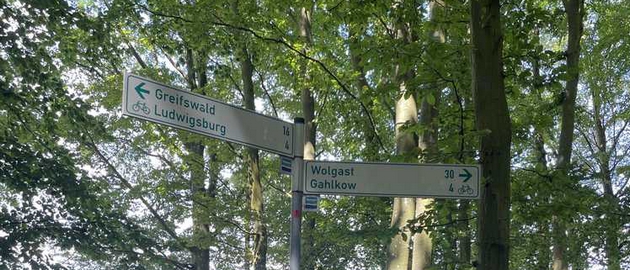Ecological Tourism in Europe and Linking Tourism & Conservation (Ö.T.E and LT&C) has begun work on an EU-funded project to promote cycle tourism in central Europe. It is the first project the two organizations will jointly undertake since the merger announcement.
The three-year project aims to develop the tourism potential of the EuroVelo 13 ‘Iron Curtain Trail’ and promote sustainable tourism, especially with small and medium-sized enterprises (SMEs) along the route.
The Innovative participatory sustainable business model for cycling along the Iron Curtain Trail (ICTr-CE) project covers 3,000 km of the 10,000 km long EuroVelo 13 (E13) and overlaps with the European Green Belt.
Ö.T.E and LT&C’s involvement in the project covers the trail from Germany to Poland along the Baltic Sea, most of which is in protected areas.
The ICTr-CE project began in March this year and is due for completion in February 2026. Funded by the Interreg Central Europe Program, it has a total budget of €2,67m.

From Stralsund to Gdańsk
The German section of the route, which starts in Stralsund on the German Baltic Coast and ends at the German-Polish border in Świnoujście, is under the responsibility of Ö.T.E and LT&C to implement the project’s activities and has a budget of €191,520.
Ö.T.E and LT&C will work in cooperation with the Mecklenburg-Vorpommern Tourism Board, cycle route experts, and the Tourism Association Vorpommern, quality and sustainability experts.
From the German-Polish border to Gdańsk, the route is managed by the Marshal Office of Pomerania and the City of Gdańsk.

This route from Stralsund to Gdańsk is known as the Northern pilot area, one of three pilots in the project.
Working closely with rural and urban SMEs and regional tourism organizations, the project includes promoting innovative and participatory business models, developing tourism products with online bookable offers, and a mentoring program to support SMEs with environmental and digital entrepreneurial skills.
A footprint calculator will be adapted, and data gathered on the environmental, social, and economic impacts of tourism in the region.
As compensation for possible negative impacts, the project partners are planning a ‘Good Impact Program’ where cycle tourists can provide financial support to local initiatives targeting, for example, nature conservation.
Michael Meyer, LT&C’s co-chair and Ö.T.E’s tourism manager said: “Although the project aims are challenging, to create a balanced and measurable assessment between the three pilot areas’ impacts caused by cycling tourists along the E13 long-distance route, there is great potential to widely spread our work, not only to the entire E13 route but also to other long-distance routes across Europe.
This will certainly help to enhance, on one hand, visitors‘ views on the value of nature and, on the other hand, increase financial support to nature conservation in and around protected areas.”

Photo: Ö.T.E
Goals and challenges
In 2005, the European Parliament recognised the Iron Curtain Trail as a model project for sustainable tourism.
However, despite its potential as a tourism product, the trail lacks awareness, innovation, and recognition on a local level of the positive impact of cycle tourism.
SMEs and tourism sector organizations also lack capacity and face challenges such as putting in place the necessary environmental and digital solutions to develop tourism.
Cooperation is key
The Iron Curtain Trail crosses and links up almost all Central European countries’ border areas.
The project has 12 main partners, including Ö.T.E and LT&C, and associated partners from tourism boards and councils, NGOs, universities, SMEs, and international organizations.
It also involves nine countries: Hungary, Slovenia, Slovakia, Austria, Czechia, Poland, Belgium, Croatia, and Germany.
The project’s lead partner is Westpannon Regional and Economic Development Public Nonprofit Ltd., based in Hungary.
With diverse partners and stakeholder groups, collaboration and cooperation are vital to achieving the project’s objectives:
- Create marketable and integrated tourism products based on best practice examples
- Strengthen local economies, especially those in rural border regions
- Enable smaller, local tourism providers to adopt cooperative marketing tools and appear in international markets.

Photo: Council of Europe
Cycling the Iron Curtain Trial
EuroVelo is the European cycle route network, and the EuroVelo 13 is one of its longest routes which retraces the ‘Iron Curtain’, a border that stretched from the Barents Sea to the Black Sea and divided Europe into East and West for half a century.
With significant historical and cultural importance, E13 was certified as a cultural route by the Council of Europe in 2019.
Following the route, cyclists can visit 20 countries, 14 UNESCO sites, three seas, and numerous national parks.
It passes historic buildings, monuments, museums, and landmarks, which are reminders of Europe’s divided history.
With varied landscapes and flora and fauna, the national parks along the route are almost untouched because of their location in border areas.
The Iron Curtain Trail was an initiative of the German Green Member of the European Parliament, Michael Cramer.
You can read a brochure on the trail produced by Michael Cramer here.
For more details on Ö.T.E and LT&C’s involvement in the cycle trail, visit Ö.T.E’s project page.



